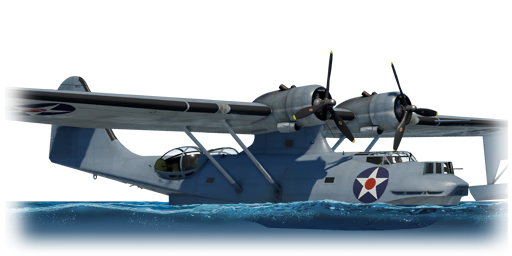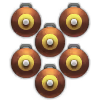



The PBY-5 Catalina was one of the most widely produced and used seaplanes in WWII, with a lifetime so extended, that some can be found today being used for civilian applications. Before the start of WWII, many critics said that the era of the seaplane had ended, because of their low speed. However the Catalina managed to grab the attention of the United States thanks to its amazing range, durability, and very large payload, meaning that it could be equipped to do several missions in a single run. The Catalina was largely used in the Atlantic and in the Pacific region, it was also exported to several Allied nations, including the Soviet Union, in which it gained an excellent reputation. It was mostly used for reconnaissance, however it was also used to hunt German U-Boats in the Atlantic, many times flying alongside convoy groups.
It has been in the game since the start of the Open Beta Test prior to Update 1.27. The PBY-5 Catalina is a capable bomber thanks to its very large payload, however it is a very large target, so it can be easily shot down by fighters without much trouble. The payload of the Catalina is one of the bests for its rank, being capable of carpet bombing large areas of ground battles or destroy entire ships in naval battles, of course it can also destroy several bases in air battles. One torpedo is often enough to sink pretty much anything in the game except carriers that require two. The flight performance of the Catalina leaves a lot to be desired, it is slow to accelerate and has a slow top speed, making it an even easier target for fighters and AA. It has a decent defensive armament, with the sides being covered by 12.7 mm HMGs and the rest by 7.62 mm, this can be enough to deal with a single biplane, but it will not hold against groups of two or three enemies at once.
flaps
flaps
flaps
brake
| Belt | Belt filling | Armor penetration (mm) at a distance: | |||||
|---|---|---|---|---|---|---|---|
| 10 m | 100 m | 500 m | 1000 m | 1500 m | 2000 m | ||
| API-T/AP/AP/I | 30 | 27 | 20 | 13 | 9 | 6 | |
| AP/AP/AP/API-T | 30 | 27 | 20 | 13 | 9 | 6 | |
| AP-I/I/AP-I/API-T | 28 | 26 | 18 | 11 | 7 | 4 | |
| Belt | Belt filling | Armor penetration (mm) at a distance: | |||||
|---|---|---|---|---|---|---|---|
| 10 m | 100 m | 500 m | 1000 m | 1500 m | 2000 m | ||
| T/Ball/Ball/AP/I | 13 | 12 | 7 | 3 | 2 | 0 | |
| T/AP/AP/AP/I | 13 | 12 | 7 | 3 | 2 | 0 | |
| Name | Weight | Slot | ||||||
|---|---|---|---|---|---|---|---|---|
| 49.9 kg |  |  |  |  | ||||
| 242.6 kg |  |  |  |  | ||||
| 500.8 kg |  |  |  |  | ||||
| 494.4 kg |  |  |  |  | ||||
| 6 × | 299.4 kg |  |  | |||||
| 884 kg |  |  | ||||||
| 964.8 kg |  |  | ||||||












Flight performance | |
|---|---|
Survivability |
|---|
Weaponry | ||
|---|---|---|